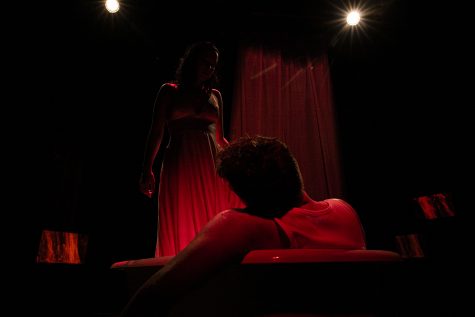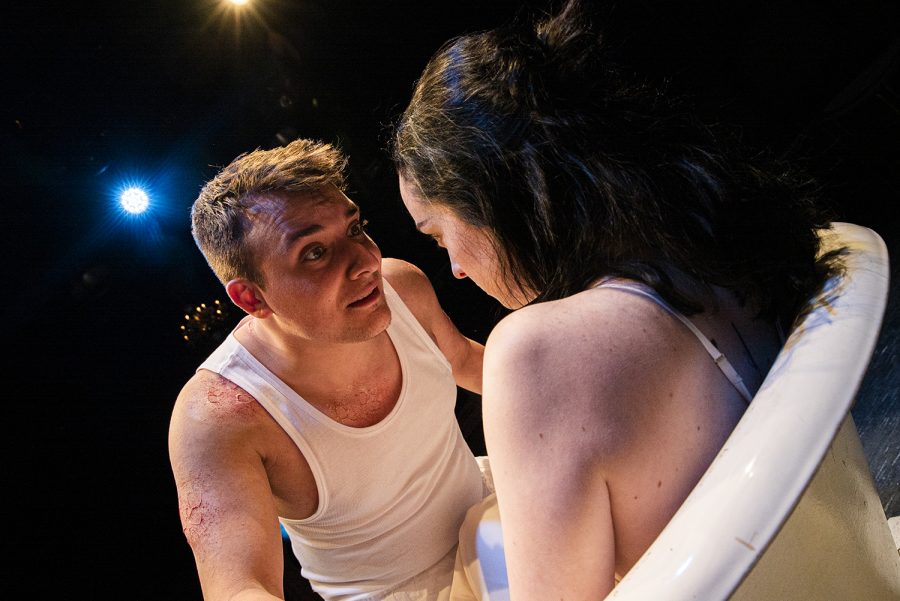Marat’s Dead to bring the story of the Reign of Terror into future America
Marat’s Dead retells and remakes the story of the death of Jean-Paul Marat in 1793 by the hands of his lover Charlotte Corday.
Actors Sterling Isler and Sydney Kuhel perform in Marat’s Dead at the University of Iowa Theatre Building on Tuesday, March 10, 2020.
March 11, 2020
The famous painting of the death of Jean-Paul Marat gets a different twist in the poster for the upcoming play Marat’s Dead. On the originally white sheet that Marat leans against, the American flag drips down in an almost impressionistic interpretation. Marat’s Dead will tell a new tale of the moment this painting takes place in the lighting lab of the Theatre Building, running today through Saturday.
Written by University of Iowa third year M.F.A. student Leigh Marshall, Marat’s Dead imagines the Reign of Terror in a futuristic American setting. The play deals specifically with the moment minor noble Charlotte Corday comes to kill her lover — French journalist and member of the Jacobin party, Marat — in his bathtub.
Ten years ago, Marshall was working at Arena Stage in Washington, D.C. Around this time, much political discourse was focused on whether birth control should be included in health insurance. Many public entertainment commentators, particularly Rush Limbaugh, were speaking about the hot-bed topic on air, which led Marshall to wonder about the effects of such speech.
“I started thinking about how impactful our public figures that flash entertainment figures on the political climate [are] and do they incite people to action, or is it just what they’re saying [is] just entertaining, like they claim,” Marshall said.
This led the playwright to create Marat’s Dead in a self-described ‘white heat’ for her first year M.F.A. workshop class, centering it on the dramatic moment that helped push the French Revolution of 1789-1799 forward.

Actors Sterling Isler and Sydney Kuhel perform in Marat’s Dead at the University of Iowa Theatre Building on Tuesday, March 10, 2020.
Even though the play is rooted in history, Marshall hinted at some deviation from what truthfully transpired.
“I think there’s going to be some surprises,” Marshall said. “You might think you know what’s going to happen if you know the history of the French Revolution or even recent American history, but who knows? Maybe history can be changed.”
Erica Vannon volunteered to direct the play the first time she read it in she and Marshall’s shared first year workshop class. Vannon is a fellow third year M.F.A. student at the UI.
RELATED: Sarah Ruhl’s translation of Three Sisters to premiere at UI Theatre Department
Vannon said she loved the play when she first read it. As the Department of Theatre Arts’ resident intimacy choreographer, she found there was a lot of energetic and coercive exchanges throughout the play.
“I got really excited about exploring the ways that manifests on stage, via language, but also between interaction of the actors, and I thought the script was tight and concise and smart,” Vannon said.
Marat’s Dead features only two actors and utilizes the lighting lab’s small, intimate space, making it an interesting challenge for Vannon. Extra pre-filmed footage will be projected on the walls, and the small audience will be much closer than usual to the action.
“I’ve been able to sort of stretch my directorial muscles as it were for both directing for the stage, thinking about the media, and then also getting into the world of intimacy and violence,” Vannon said.
UI senior and dramaturg Hannah Schillinger has worked on two other plays as an assistant dramaturg, but this is her first time working as head dramaturg. She said when she first read the play, it was unlike any she had ever worked on.
“I’ve really enjoyed delving into these two characters, who they were historically, and then looking at how that is reflected in the play that we’re creating,” Schillinger said. “How much of this history do we want to bring? What point do we stop relying on history, and use that as a basis, but also create something that is new?”
Editor’s Note: a previous version of this story including photo cutlines incorrectly stating that the French Revolution took place in the 17th century. The cutlines have been updated to reflect this correction. The DI regrets the error.



